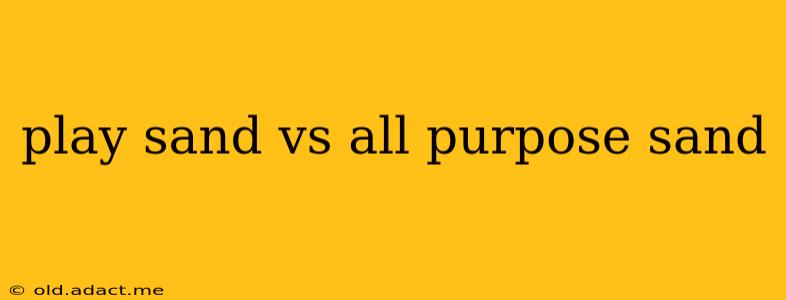Choosing the right sand for your project can feel like navigating a desert—pun intended! Whether you're building a magnificent sandcastle, creating a vibrant sandbox for your little ones, or tackling a larger construction project, understanding the differences between play sand and all-purpose sand is crucial. This guide will delve into the key distinctions, helping you make an informed decision.
What is Play Sand?
Play sand, as the name suggests, is specifically designed for children's play areas. It's carefully screened to remove sharp objects, rocks, and potentially harmful debris. This meticulous cleaning process ensures a safe and enjoyable experience for kids. The grains are generally finer and smoother than those found in all-purpose sand, minimizing the risk of cuts or scrapes. Play sand is also typically washed to remove impurities and reduce the likelihood of dust and irritants.
Is Play Sand Safe for Kids?
Yes, play sand is generally considered safe for children when sourced from reputable suppliers. However, it's crucial to supervise children while they play to prevent accidental ingestion. Always check the packaging for any warnings or recommendations from the manufacturer. Remember, even play sand can contain trace amounts of minerals, so handwashing after playtime is recommended.
What is All-Purpose Sand?
All-purpose sand, also known as construction sand or general-purpose sand, is a more versatile product. It's used in a wider range of applications, from construction and landscaping to mortar mixing and artistic projects. Unlike play sand, all-purpose sand isn't typically washed or screened to the same degree. This means it may contain larger particles, sharper edges, and potentially more impurities. Its composition can vary depending on the source and intended use.
What are the Uses of All-Purpose Sand?
All-purpose sand finds its place in a multitude of projects:
- Construction: Used in concrete mixes, mortar, and as a base for foundations.
- Landscaping: Provides drainage, improves soil texture, and is used in pathways and decorative features.
- Mortar Mixing: An essential component in creating strong and durable mortar for bricklaying and other masonry work.
- Artistic Projects: Used in crafts, pottery, and other artistic endeavors.
Play Sand vs. All-Purpose Sand: Key Differences Summarized
| Feature | Play Sand | All-Purpose Sand |
|---|---|---|
| Grain Size | Fine, smooth | Variable, can be coarse |
| Cleaning | Thoroughly washed and screened | Less thoroughly cleaned |
| Safety | Designed for children's play, safer | May contain sharp objects and impurities |
| Cost | Typically more expensive | Generally less expensive |
| Applications | Primarily children's play areas | Wide range of construction and landscaping uses |
Can I Use All-Purpose Sand for a Sandbox?
While you could technically use all-purpose sand for a sandbox, it's strongly discouraged. The presence of sharp particles, rocks, and potential contaminants poses a significant risk to children's safety. Investing in play sand ensures a safer and more enjoyable experience for your little ones.
Which Type of Sand Should I Choose?
The best type of sand depends entirely on your project's needs:
- Sandboxes and children's play: Always opt for play sand. Safety should be the top priority.
- Construction, landscaping, or artistic projects: All-purpose sand is generally sufficient, but always check the specifications for your particular project to ensure it meets the required criteria.
By understanding the differences between play sand and all-purpose sand, you can make informed choices that ensure safety and project success. Remember, choosing the right sand can significantly impact the outcome and enjoyment of your endeavors.
